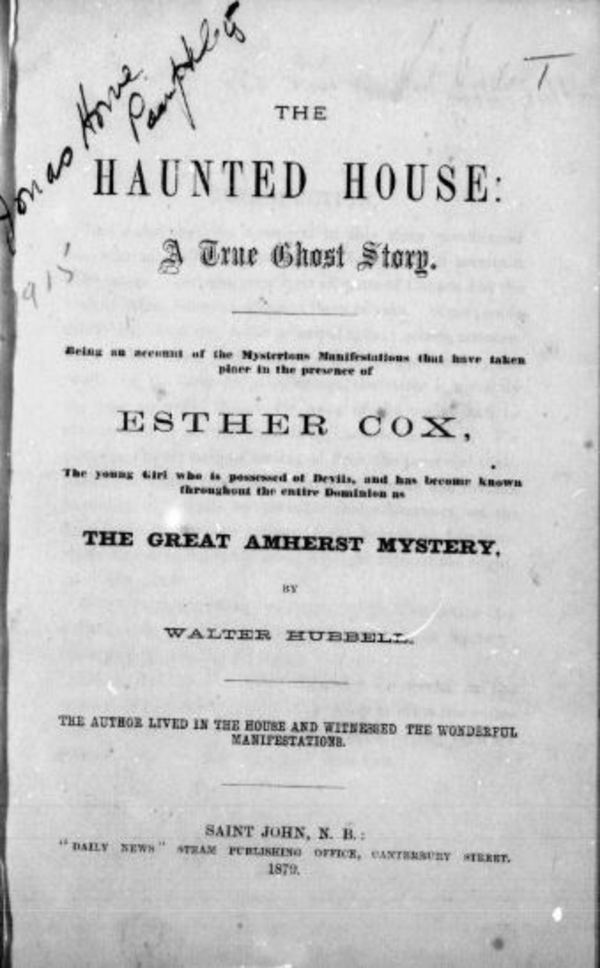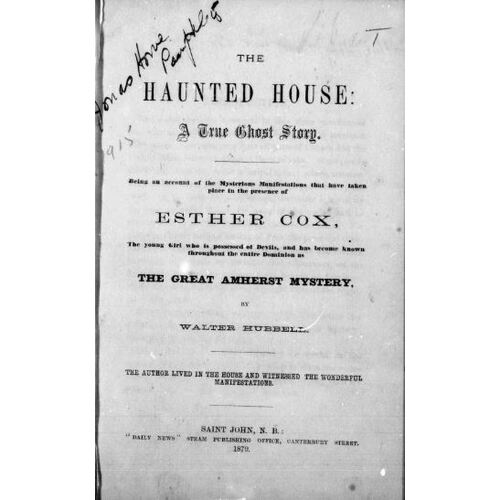
Source: Link
COX, ESTHER (Porter; Shanahan), b. 28 March 1860 in Upper Stewiacke, N.S., youngest of at least six children of Archibald Cox and Esther T. —, farmers; m. first 3 March 1882 Adam Porter in Springhill, N.S., and they had one son; m. secondly 23 July 1896 Peter Shanahan in Amherst, N.S.; d. 8 Nov. 1912 in Brockton, Mass.
Esther Cox began experiencing unexplained phenomena in late August 1878 after being assaulted by her boyfriend, Bob MacNeil. The manifestations of a poltergeist continued for more than a year. For much of this time Esther lived in Amherst with her eldest sister, Olive, and her husband, Daniel Teed, and her experiences became identified as the “great Amherst mystery.”
The poltergeist took different forms, expressing itself originally through the movement of bedclothes and other articles and through loud rappings. By October 1878 manifestations were more aggressive; furniture was tipped over and Esther complained of being pursued by objects, especially when in the basement. The poltergeist communicated with observers, answering their questions with knocks and, at times, by writing on walls. While some of the written messages were too profane to be published in newspapers, the sensational “Esther Cox, you are mine to kill” was widely reported. After the ghost threatened to burn down the Teed home, lighted matches reportedly fell from the ceiling and two unexplained fires were discovered. From the beginning Esther suffered physical symptoms that included spells characterized by swelling of her body and uncontrollable movement of her limbs.
In June 1879 Cox began to tour, accompanied by actor and writer Walter Hubbell and a local businessman, John White. They returned home following only two engagements in New Brunswick, however, after they were frightened by disapproving members of the audience.
Esther’s manifestations ended in November 1879. At that time she was sentenced to four months in jail for burning down a barn belonging to the family with whom she was living. Reportedly she was released at public urging after serving one month. Subsequently, no accounts of disturbances appear in newspapers. One interpretation is that she had been cured by a Micmac shaman. In 1882 she had married and was living in Springhill. Apparently her married life was unaffected by poltergeists and she ended her years quietly in Brockton, Mass., where few, if any, knew of her earlier fame.
Many have tried to assess the meaning of Esther’s experiences. Extensive newspaper coverage included debates that pitted those – including Esther and her family – who offered supernatural explanations against those who believed the poltergeist was a hoax. Members of the educated, scientific community countered what they regarded as supernatural folk belief with explanations that credited Cox with the ability to mesmerize others, making them think they witnessed things they did not, or linked her with developing theories of electricity and magnetism. Recent studies that interpret hysteria as a vehicle of Victorian women’s resistance suggest that the manifestations may have been an expression of the powerlessness Cox felt as a victim of assault and as a domestic in her sister’s home. However, because her voice was often drowned out by others who claimed authority to speak about the mystery’s meaning it is impossible to appreciate fully her side of the story.
Newspaper accounts of Esther Cox’s experiences appear in August 1878–November 1879 issues of the Halifax Acadian Recorder, Morning Chronicle, and Presbyterian Witness, the Chignecto Post (Sackville, N.B.), and the Daily Times (Moncton, N.B.).
NA, RG 31, C1, 1871, 1881, Colchester County, N.S.; 1881, 1891, Cumberland County, N.S. PANS, RG 32, WB, Cumberland County, no.34/1882, no.116/1896. Walter Hubbell, The great Amherst mystery: a true narrative of the supernatural (Amherst, N.S., [1888?]; repr. 1982; copy of reprint available at PANS); The haunted house: a true ghost story; being an account of the mysterious manifestations that have taken place in the presence of Esther Cox, the young girl who is possessed of devils, and has become known throughout the entire dominion as the great Amherst mystery (Saint John, 1879). David St Clair, Mine to kill (Toronto, 1986).
Cite This Article
Diane Tye, “COX, ESTHER (Porter; Shanahan),” in Dictionary of Canadian Biography, vol. 14, University of Toronto/Université Laval, 2003–, accessed December 29, 2025, https://www.biographi.ca/en/bio/cox_esther_14E.html.
The citation above shows the format for footnotes and endnotes according to the Chicago manual of style (16th edition). Information to be used in other citation formats:
| Permalink: | https://www.biographi.ca/en/bio/cox_esther_14E.html |
| Author of Article: | Diane Tye |
| Title of Article: | COX, ESTHER (Porter; Shanahan) |
| Publication Name: | Dictionary of Canadian Biography, vol. 14 |
| Publisher: | University of Toronto/Université Laval |
| Year of publication: | 1998 |
| Year of revision: | 1998 |
| Access Date: | December 29, 2025 |



